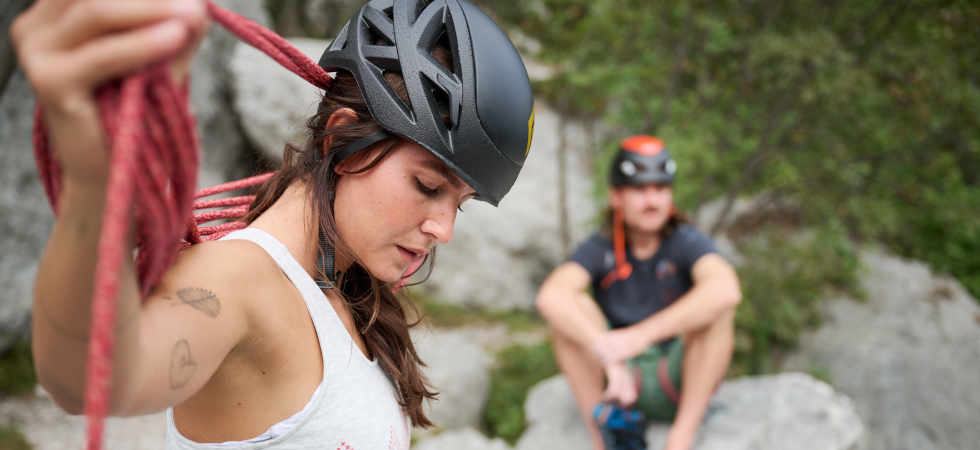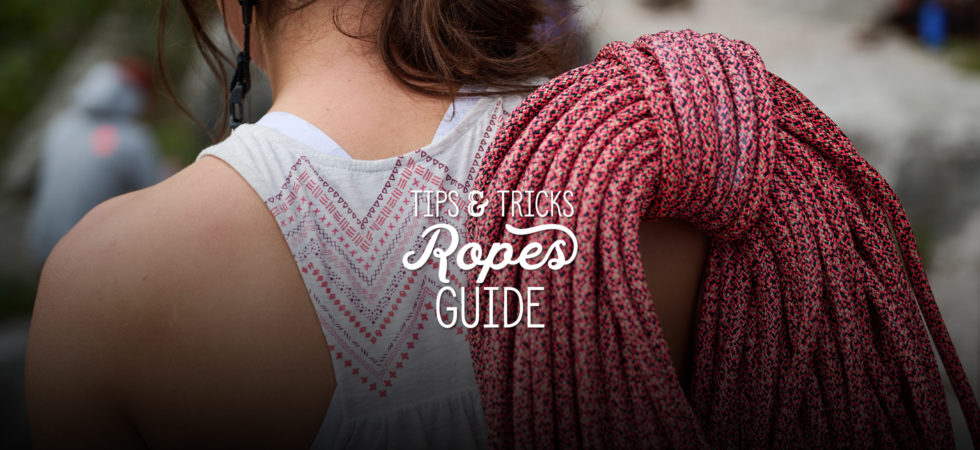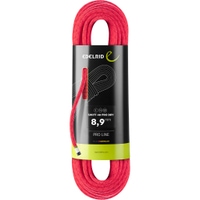When buying climbing equipment there is a lot to consider – harness, helmet, climbing shoes, belaying device and above all you need the right rope. In this guide, we will show you which different types of ropes there are, which type of rope you need for which type of climbing and what else you need to be aware of when buying a rope. We also give you tips for proper rope care and storage – because once purchased you want to be able to use your rope for as long as possible, right?
different types of ropes & their use
The most important difference in climbing ropes are the three different types: Single rope, half rope and twin rope. They all belong to the group of dynamic ropes – which means that they have a slight elasticity and can catch your fall properly. Before we go into all other characteristics of climbing ropes, we will explain to you what these rope types are all about and when which rope is used.

Single Rope
The single rope is the most commonly used climbing rope. Single rope means that unlike twin or half rope, it is used in single strand. Especially for sport climbing it is the standard – both indoors and outdoors. Sometimes it is also used for alpine climbing, ice climbing and big wall climbing.
The big advantage of the single rope is its easy handling – less rope means less mix-up. In addition, you can use the single rope with common safety devices such as the Grigri from Petzl. When abseiling, however, the single rope cannot keep up with a half or twin rope: With double ropes, you can abseil much faster, because the double-length allows longer abseiling distances – the entire rope length can be used instead of only half. Especially in alpine terrain, this can offer a decisive advantage in the event of a sudden weather change.
In addition, the double ropes also offer a kind of double safety. If one rope is cut in an extreme situation, such as a rockfall, the second rope prevents a fall.
Half Rope
The half rope is mainly used for climbing in alpine terrain, for self-belaying routes and also for trad climbing. Like twin ropes, half ropes are only suitable to be used in a double strand – otherwise the necessary safety is not given. The main difference to the twin rope is that only one strand of the half rope has to be hooked in for intermediate securing. This optimizes the rope course and reduces rope friction. In a three-roped party, you can move fast, as the leader climbs with both ropes and can secure the two followers to the single strand.
Since the half rope is used in pairs, it is thinner than a single rope. As already mentioned, it still offers greater protection in alpine terrain – should one rope break due to falling rocks or a sharp edge, the second strand prevents a fall. However, double-stranded use requires special safety devices such as tubes or HMS carabiners.
Twin Rope
The twin rope is a combination of single rope and half rope. Twin ropes are used like half ropes in a double strand, but as with single ropes, both ropes are hooked into each interim fixation. In case of a fall, both ropes are strained. For this reason, twin ropes are even thinner than half ropes and are characterized by a low weight and a small diameter. They are therefore mostly used by experts – when every gram counts.
While twin ropes – like half ropes – are superior to single ropes in terms of abseiling and safety, they cannot provide a reduced rope friction. Twin ropes are used similar to half ropes – in alpine terrain, but also for ice and mixed climbing.
Rap Line
Although not a climbing rope, but still a rope that you always need when climbing, is the rap line. The rap line is thinner and lighter than a climbing rope and is also a static rope. That is, it has very little stretch, which is why it cannot be used for climbing. Rap lines are primarily intended to help out in emergency situations, to pull up material or to supplement belays.
Other features of climbing ropes
Apart from the different types of ropes, there are other features you need to consider when buying a climbing rope. Above all these include the length and diameter – because not every single rope, half rope and twin rope has the same length and thickness.
Length
The right rope length depends on what you mainly use the climbing rope for. For climbing indoors, for example, you need a shorter rope than for multi-pitch tours in alpine terrain. For this reason, climbing ropes are available in lengths between 40 and 80m.
When rock climbing outdoors, you should take a closer look at the topography of the route in advance – character and style. Depending on the length of the tour and the length of the abseiling places, you should choose the rope length. In climbing guides or on the internet you will usually find a recommendation for the respective route. However, a rope with a length of 70m should be sufficient in most cases.
When doing multi-pitch routes, however, 70m is a little short, especially for abseiling. It is usually better to use half ropes with a length of at least 60m. That also depends on how much weight you want to carry.
For shorter routes in the climbing garden, a 60m rope is usually long enough. You can use such shorter ropes in the climbing hall as well – but not less than 60m either, because the new halls are getting bigger and higher. It is best to inform yourself in advance directly at the climbing hall you are planning to go to about the recommended length.

Diameter
In general, the thicker the rope, the more robust it is. Therefore, the number of falls that a rope should “survive” increases with a higher diameter. A thicker rope thus has a longer service life than a thinner one. At the same time, a larger rope diameter naturally also means higher weight and higher friction in the interim fixations and in the belaying device – making climbing more strenuous. You should therefore always make sure that the rope thickness matches your belaying device!
For single ropes, diameters between 9 and 10mm are usually ideal. If you do a lot of Toprope and indoor climbing, where a lot of friction is on the rope, you can take a slightly thicker one. Half ropes and twin ropes are thinner due to double-stranded use. The diameter of half ropes is between 7.5 and 9mm, while twin ropes are already available from 6.9mm upwards.
Impregnation
If you use your climbing rope mostly outdoors, it is important to protect it as well as possible from moisture, dirt and UV radiation. Therefore you should definitely buy a rope with impregnation. During the rope manufacturing process, the impregnation is applied directly to the individual components. The impregnations therefore usually last very long – often as long as the rope itself. Unfortunately, such an impregnation cannot be renewed, nor can it be applied afterward. That’s why it is important to inform yourself well before the purchase.
rope care & replacement
To be able to use your rope for as long as possible, the right care is crucial. We will therefore show you which things you should pay attention to and also when it is necessary to get a new rope.
Rope: Right Storage
If you are not using your rope, you should keep it in a clean and dry place. Ideally, it should also be cool and dark, because UV radiation damages the polyamide of the rope. A rope bag is perfect for this purpose. It protects the rope not only from dirt, but also from the sun. Moreover, the rope does not become knotted so easily – if you attach the ends to the loops provided for it – and is ready for the next climbing adventure much faster again.
Rope: Right Cleaning
Even if you always keep your rope in the rope bag, it can get dirty. Since climbing ropes are made of textile, luckily this is no problem at all. You can wash them without hesitation: either by hand in the bathtub or in the washing machine at 30°C with a gentle cycle. You can use a special rope detergent or simply any mild one. It is also important that you neither spin-dry the rope in the washing machine nor put it in the dryer! It is best to lay it loosely on the floor in a cool, dark place – do not hang it up or put it in the sun.
Rope: Replacement
Since safety has top priority when climbing, you should check your rope regularly. Simply let it run through your hands from one end to the other to feel possible irregularities and damages. Especially after a wide fall or after a rockfall you should check it carefully.
How long you can use your rope depends on how and how much you climb – there is no exact guideline. However, you can orientate yourself a little bit towards the number of falls after which a rope should be replaced – it is usually specified by the manufacturer. Apart from that, you should get a new rope when…
- the sheath of the rope is damaged heavily (you can see the core)
- the sheath has shifted significantly
- the sheath is heavily worn
- the rope shows strong deformations such as kinks, stiffening or sponginess
- traces of melting are visible due to strong friction
- the rope has come into contact with acids or other chemicals
Even if you hardly or not at all use the climbing rope, the plastic fibers age. Therefore you should not use a “new” rope that is older than ten years anymore.
Foto Header: ©Petzl, Sam Bie
















